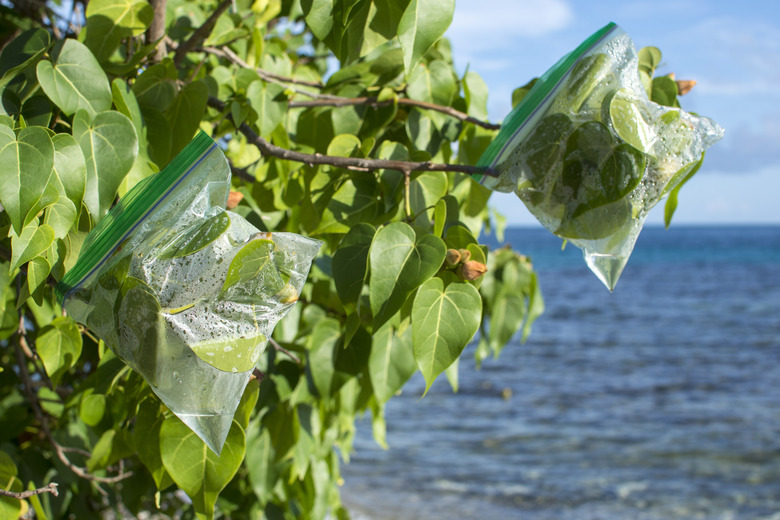How Do Living Organisms Contribute To The Water Cycle?
The water cycle defines the process in which water moves continuously above and below the surface of the Earth. Bodies of water, clouds, evaporation and condensation all play a part in the water cycle, but living things also occupy a vital role in this process. Without the contribution of living organisms, water would not disperse across the planet in the way it does today.
TL;DR (Too Long; Didn't Read)
Bodies of water, clouds, evaporation and condensation all play vital roles in the water cycle, but so do living things. Plants, especially trees, contribute to the water cycle via transpiration, where water evaporates from the surface of their leaves. Close to 10 percent of all water enters the water cycle due to plant transpiration. Animals contribute to the water cycle via respiration, perspiration and urination.
The Water Cycle
The Water Cycle
To understand the role of living organisms in the water cycle, it helps to understand the basics of the cycle itself. When water evaporates from the world's oceans, lakes and rivers, it turns into water vapor and travels into the atmosphere where it forms into clouds. As the water vapor in the clouds condenses, droplets of rain begin to fall. The rain replenishes lakes and rivers not only by falling directly on them, but by seeping into the ground and forming springs, through a process called infiltration. Groundwater then seeps back into the ocean, where the cycle repeats.
Without the water cycle, freshwater lakes and rivers would not exist and living things would not be able to thrive on land far from the ocean. Living organisms do not just benefit from the water cycle — they participate in it. The contributions of living organisms to the water cycle are vital.
How Plants Contribute
How Plants Contribute
Plants, particularly trees, contribute greatly to the water cycle because of the processes they use to absorb and release energy. Unlike animals, which get their energy from food, plants convert sunlight into usable energy through photosynthesis. Plants also absorb nutrients and water through their roots.
When a tree absorbs water, it travels throughout its branches to its leaves. Needed for photosynthesis, trees and plants cannot get the energy they need from the sun without water. During photosynthesis, some excess water evaporates from the surface of the leaves, becoming water vapor. The water vapor in the process of transpiration travels into the atmosphere and becomes part of the water cycle, in the same way as evaporated water from lakes, rivers and oceans.
At first glance, it may not seem that plant transpiration contributes that much to the global water cycle. But plants and trees supply a large amount of the world's water via this process. About 10 percent of all water enters the cycle via plant transpiration.
How Animals Contribute
How Animals Contribute
Though they don't contribute as much as plants, animals still supply some of the water present in the water cycle. Animals contribute water mainly through breathing, perspiration and urination.
When animals breathe, their warm lungs fill with air. Inside the lungs, some of that air condenses into water vapor. When an animal exhales, they release more water vapor than they breathed in, which adds to the water present in the water cycle.
Many animals also sweat to cool down. When droplets of sweat evaporate from the surface of an animal's skin, they take a bit of the animal's body heat with them. They also turn into water vapor and enter the water cycle, just like water evaporating from plant leaves.
When animals consume water, they urinate to expel the excess, which then then evaporates and re-enters the water cycle. Even animal dung contains some water which may re-enter the cycle in the same way.
Though trees represent the biggest living contributors to the water cycle, animals also play a valuable role in recycling Earth's water. Without living creatures, the water cycle's effectiveness diminishes, and less water recycles. Though often not included in the explanation of the water cycle, all living organisms contribute to it in their distinctive ways.
Cite This Article
MLA
Cook, Maria. "How Do Living Organisms Contribute To The Water Cycle?" sciencing.com, https://www.sciencing.com/do-organisms-contribute-water-cycle-5635024/. 11 April 2018.
APA
Cook, Maria. (2018, April 11). How Do Living Organisms Contribute To The Water Cycle?. sciencing.com. Retrieved from https://www.sciencing.com/do-organisms-contribute-water-cycle-5635024/
Chicago
Cook, Maria. How Do Living Organisms Contribute To The Water Cycle? last modified March 24, 2022. https://www.sciencing.com/do-organisms-contribute-water-cycle-5635024/
